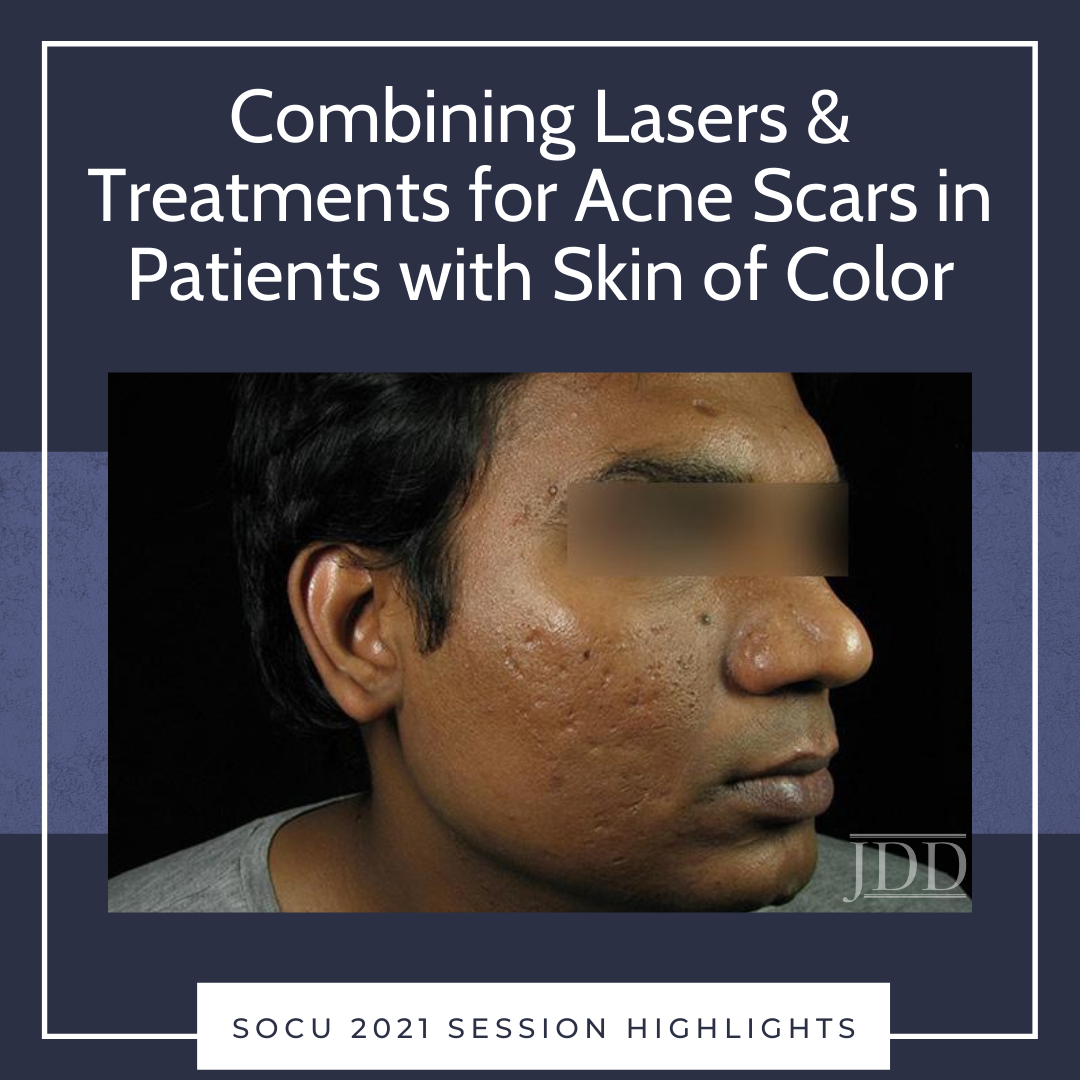Acne scarring affects many of our acne patients and can lead to a great impact on quality of life and self-esteem. Treating acne scars aggressively in skin of color patients can be challenging, given the risk of side effects associated with different procedures. In her lecture entitled: Combining Lasers & Treatments for Acne Scars in Patients with Skin of Color – This is How I Do It, Dr. DiAnne Davis, a board-certified and fellowship-trained cosmetic dermatologist, walks us through her acne surgery protocol so we can safely and effectively treat our acne scarring patients.
Dr. Davis, who is currently practicing at North Dallas Dermatology Associates, began her lecture by emphasizing 4 key objectives:
-
- Review the different types of acne scars
- Discuss considerations when selecting treatment modalities for different types of acne scars
- Demonstrate effectiveness of different modalities for treating acne scars
- Explain how to combine multiple modalities to approach acne scars
Acne Scars
As we know, acne scars can be difficult to treat and can negatively influence patient’s self-esteem and quality of life. The 3 common types of acne scars include ice pick, box car, and rolling scars. When treating patients with acne scars, we should also consider post-inflammatory hyperpigmentation, post-inflammatory erythema and persistent cystic nodules. Dr. Davis mentions, we should ask ourselves: How can I treat the scars effectively and aggressively without harming any of the surrounding skin? How can I give patients the best bang for their buck?
Protocol Considerations
When selecting the right treatment modality, it is important to determine if the patient still has active acne and what past treatments they have used. Acne should be well-controlled before pursing more aggressive procedures. Further, one must assess the type of acne scarring and the risk of pigmentary alterations. Dr. Davis thoroughly assesses her patients by looking at all areas of the skin to determine how severe their hyperpigmentation can be. For instance, if they have hyperpigmentation lasting 2 months or longer, that means their risk for hyperpigmentation after the procedure is high.
Effectiveness of Different Treatment Modalities
For pitted and box car acne scars, radiofrequency microneedling can be a great tool. It is an in-office treatment with minimal downtime, and importantly, safe to use in skin of color patients. At least 3 treatments are necessary 4 to 6 weeks apart, but the number of treatments can increase depending on the severity of scarring. Radiofrequency microneedling can also be combined with several modalities on top including platelet rich plasma (PRP) and poly-l-lactic acid.
For pitted acne scars in particular, Dr. Davis states that one can take it back to the basics and perform punch excisions on these scars. With punch excisions, extensive counseling must be done with the patient including performing a test spot, reviewing expectations, and educating on post-procedure care. Dr. Davis uses a 1.5-2 mm punch instrument to punch out the scar. She then uses a 6-0 prolene suture to close; sutures come out in 1 week. Patients are often left with a linear scar which can be blended with non-ablative fractional therapy after.
Multiple Modalities to Approach Acne Scars
For patients with multiple acne scars of different types, Dr. Davis uses an acne surgery protocol she learned and customized in fellowship. This protocol is indicated for patients with rolling, box car and extensive pitted scars. For patients with oily skin, she often recommends treatment with oral isotretinoin (1 mg/kg) two weeks pre and two weeks post-procedure. This is important because oil can actually cause skin edges to not approximate adequately leading to suboptimal results. Below are the steps of Dr. Davis’s acne surgery protocol:
-
- Tumescent anesthesia
- This creates an even and safe plane so that it is easier to perform the subcision.
- Tumescent anesthesia
-
- Extensive subcision using the “Taylor Liberator”
- The Taylor Liberator is a blunt tip device that facilitates the breaking of fibrous bands of tissue.
- Davis emphasizes that the device should be angled up, giving the appearance of a “mouse under the blanket.” Proper angling is important to avoid the disruption of blood vessels and nerves.
- Extensive subcision using the “Taylor Liberator”
-
- 20% TCA chemical peel
- This should be applied to the entire face to help with blending during the healing process.
- 20% TCA chemical peel
-
- 4-6 passes of either ablative fractional laser (AFL) or non-ablative fractional laser (NAFL) therapy (depending on which laser is best suited for the patient’s skin type) ablative fractional laser therapy.
-
- Punch Excision (if applicable)
-
- Additional options including Kenalog, platelet-rich plasma (PRP), poly-l-lactic acid, calcium hydroxylapatite, adipose tissue
- One or more of these can be applied topically at the end of the procedure to aid in preventing hyperpigmentation and to help with healing time.
- Additional options including Kenalog, platelet-rich plasma (PRP), poly-l-lactic acid, calcium hydroxylapatite, adipose tissue
-
- 100% sun protection!
- All patients should be adequately educated on the necessity of sun protection following this protocol.
- 100% sun protection!
Dr. Davis ended her lecture by showing several impressive before and after pictures of her personal patients undergoing the acne surgery protocol. All photos that she shared were patients of skin of color with varying phototypes.
In summary, there are various safe and effective ways to treat acne scarring in skin of color patients. Depending on the severity of scarring, patients may benefit from more advanced techniques like those discussed in Dr. Davis’s acne surgery protocol.
This information was presented by Dr. DiAnne Davis at the 2021 Skin of Color Update virtual conference held on September 10-12-2021. The above highlights from her lecture were written and compiled by Dr. Kamaria Nelson.
Clinical image used with permission from the Journal of Drugs in Dermatology.
Did you enjoy this article? Find more on Skin of Color Dermatology here.

